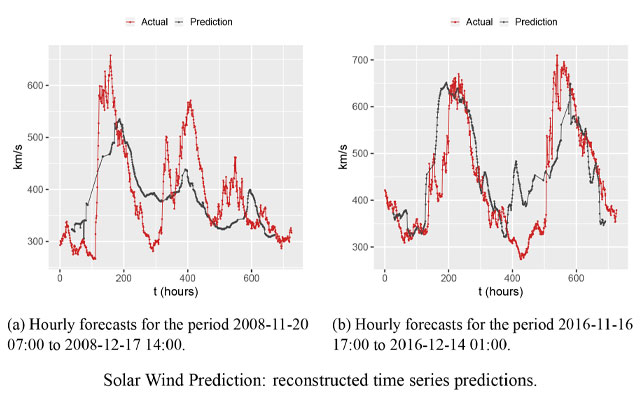By Kimberly Bruch, SDSC Communications
Heliophysicist Bala Poduval has dedicated her space weather research to predicting the solar wind conditions that cause these storms, with a recent highlight being the validation of a machine learning model that she and her colleagues developed with simulations using the Comet supercomputer at the San Diego Supercomputer Center (SDSC) at the University of California San Diego.
“To mitigate the adverse effects of space weather, it is necessary to forecast these events with sufficient lead time so that appropriate safety precautions can be taken,” said Poduval, a research scientist with the University of New Hampshire. “One of the important pieces of information we needed to improve our prediction model was the ambient solar wind velocity near the Earth.”
Using Comet, Poduval and her international colleagues were able to validate a model that does just that – their work was successful in predicting time-lagged effects of a cause (of solar origin), which in this case was the velocity of solar wind. To accomplish this, they used a machine learning technique called Dynamic Time Lag Regression (DTLR) and validated their work by predicting the solar wind arrival near the Earth’s orbit from physical parameters of the Sun as measured from the ground and space.
“We used the changes in the solar magnetic field, in terms of the magnetic flux tube expansion factor, as well as other characteristics of the sun such as the number of sunspots, to determine the speed of the solar wind that can be detected at Earth after a lag of ‘dynamic time’,” said Poduval. “The validation of DTLR and the solar wind forecasting would not have been possible in any reasonable time frame without using Comet since the computation of magnetic flux expansion factor for a period sufficient to train a neural network would take months on a local machine, as compared to just a few weeks with Comet.”
Poduval and her colleagues’ work was recently presented at the International Conference on Learning Representations, which was held in a virtual format due to the COVID-19 pandemic.
This research was funded by a grant from the Centrum Wiskunde and Informatica, Amsterdam. Computational work on Comet was allocated by the National Science Foundation’s Extreme Science and Engineering Discovery Environment (XSEDE) (TG-ATM170013).
About SDSC
The San Diego Supercomputer Center (SDSC) is a leader and pioneer in high-performance and data-intensive computing, providing cyberinfrastructure resources, services, and expertise to the national research community, academia, and industry. Located on the UC San Diego campus, SDSC supports hundreds of multidisciplinary programs spanning a wide variety of domains, from astrophysics and earth sciences to disease research and drug discovery. In late 2020 SDSC will launch its newest National Science Foundation-funded supercomputer, Expanse. At over twice the performance of Comet, Expanse supports SDSC’s theme of ‘Computing without Boundaries’ with a data-centric architecture, public cloud integration, and state-of-the art GPUs for incorporating experimental facilities and edge computing.
Original post https://alertarticles.info




